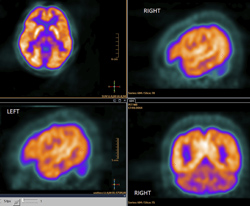New chemistry for radiolabelling
Over the past decade, PET has become a powerful clinical imaging tool for evaluating complex biochemical processes in cancer patients. Measurements of "normal" and altered biochemical pathways are routinely performed. But the continued growth of PET requires the expansion of available positron-emitting radiopharmaceuticals. Given that fluorine-18 can act as a radiotracer in PET, it was no surprise that chemists working on the 'Synthesis and evaluation of 18F-labelled N-F reagents' (SELEFLU) project have given special attention to this radioactive isotope. Fluorine-18 is the 13th most abundant element in the Earth's crust; and yet only 21 biosynthesised natural molecules containing fluorine are known. The SELEFLU chemists developed and evaluated new methods to incorporate fluorine into organic molecules by making carbon-fluorine bonds. The new bond-forming reactions allow access to organic molecules of PET tracers under copper catalysis. The so-called trifluoromethylation could be performed using iodine reagents, combining a benign environmental character with commercial availability. In addition to copper-mediated catalysis, the SELEFLU scientists have succeeded in harnessing the energy of visible light for the trifluoromethylation of silicon-containing molecules. Furthermore, new methods for labelling aromatic hydrocarbons with fluorine-18 were developed and validated. These methods should increase the number of radiopharmaceuticals routinely used in PET. SELEFLU approaches to the introduction of fluorine-18 into organic molecules have introduced a fluorine-18 chemistry characterised by high selectivity and unique efficiency. Hopefully, complicated work-up procedures will become obsolete. And the improvements in synthesis of radiopharmaceuticals should offer new possibilities for the development of drugs, especially for central nervous system diseases.
Keywords
Radiolabelling, PET, fluorine-18, radiotracers, cancer, patient, radiopharmaceuticals, organic molecule, catalysis, trifluoromethylation, silicon, aromatic hydrocarbons

